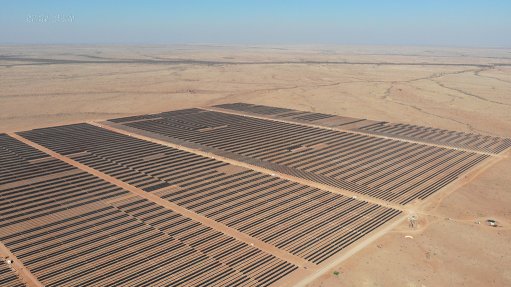Electronics company expects strong growth for fuel cell cars
A report by IDTechEx forecasts that the market value of on-road fuel cell vehicles will reach $160-billion by 2042, growing at a compound annual growth rate of 23.9% from 2022 to 2042.
The electronics company believes that incorporating a fuel cell into an electric vehicle powertrain, generating electricity from hydrogen, offers a technology pathway that delivers the critical reduction in on-road exhaust emissions, while overcoming the potential range and charging limitations of battery electric vehicles (BEVs).
“The race to decarbonise on-road vehicles is undoubtedly being led by BEVs; however, serious concern remains around whether BEV solutions can deliver the necessary duty cycle for those use cases that require significant range, brief downtime and high operational flexibility, such as long-haul trucking and high-mileage city bus operations.
“In such applications, a huge [larger than] 500 kWh battery will be required to reliably deliver [more than] 350 km of range on a single charge, and full recharging, even with 350 kW ultra-fast chargers, will take hours.
“This becomes an even greater challenge in a depot situation, where megawatts of power are required. Hyundai’s XCIENT fuel cell heavy-duty truck delivers about 400 km of range, with a 73kWh lithium-ion battery and hydrogen fuel cell system, requiring less than 20 minutes to refuel,” IDTechEx notes.
The company adds that the growing momentum pushing a rapid transition to zero-emission vehicles, combined with a genuine need for range comparable to diesel powertrains and quick refuelling, means automotive companies such as Toyota, Hyundai, General Motors and Daimler are continuing to pump millions into improving fuel cell system technology and bringing down costs.
Major automotive markets – including Japan, Korea, China, Germany and California, in the US, – are planning for the significant deployment of fuel cell electric vehicles (FCEV).
Germany has already built around 100 hydrogen refuelling stations (HRSs), offering a capacity to support 40 000 passenger cars, though their current fleet is less than 1 000.
Germany is providing a testbed for FCEV in Europe and will challenge the assertion that the lack of hydrogen infrastructure is to blame for the lack of FCEV uptake.
Relatively small fleets of heavy-duty FCEVs could provide sufficient hydrogen demand to viably operate an HRS, states IDTechEx.
Compared with cars, the value proposition for fuel cell trucks and buses is stronger, and IDTechEx does not expect fuel cell cars to be a commercial success comparative to battery-electric ones.
However, the scale of the car market and substantial support for the development of a wider hydrogen economy by governments and companies in key regions mean IDTechEx forecasts that, in 2042, 60.3% of on-road FCEV market revenue will be from the passenger car market.
Fuel cell makers will benefit from the volume of the car market to drive down costs for other sectors where the technology is more critical.
“Indeed, FCEV deployment faces considerable challenges, including decreasing the cost of fuel cell system components to reduce the upfront vehicle cost, while rolling out sufficient hydrogen refuelling infrastructure to make driving a FCEV viable.
“Also essential to the legitimacy of FCEV as a low-carbon emission solution will be the availability of cheap ‘green’ hydrogen, produced through the electrolysis of water using renewable electricity, which will be vital to FCEVs delivering the environmental credentials on which they are being sold,” IDTechEx highlights.
Cheap grey hydrogen generated from fossil fuels makes little sense as a low-emission transport fuel because the well-to-wheel emission footprint of an FCEV using grey hydrogen offers only a marginal carbon dioxide emission saving compared with modern diesel vehicles.
Comments
Press Office
Announcements
What's On
Subscribe to improve your user experience...
Option 1 (equivalent of R125 a month):
Receive a weekly copy of Creamer Media's Engineering News & Mining Weekly magazine
(print copy for those in South Africa and e-magazine for those outside of South Africa)
Receive daily email newsletters
Access to full search results
Access archive of magazine back copies
Access to Projects in Progress
Access to ONE Research Report of your choice in PDF format
Option 2 (equivalent of R375 a month):
All benefits from Option 1
PLUS
Access to Creamer Media's Research Channel Africa for ALL Research Reports, in PDF format, on various industrial and mining sectors
including Electricity; Water; Energy Transition; Hydrogen; Roads, Rail and Ports; Coal; Gold; Platinum; Battery Metals; etc.
Already a subscriber?
Forgotten your password?
Receive weekly copy of Creamer Media's Engineering News & Mining Weekly magazine (print copy for those in South Africa and e-magazine for those outside of South Africa)
➕
Recieve daily email newsletters
➕
Access to full search results
➕
Access archive of magazine back copies
➕
Access to Projects in Progress
➕
Access to ONE Research Report of your choice in PDF format
RESEARCH CHANNEL AFRICA
R4500 (equivalent of R375 a month)
SUBSCRIBEAll benefits from Option 1
➕
Access to Creamer Media's Research Channel Africa for ALL Research Reports on various industrial and mining sectors, in PDF format, including on:
Electricity
➕
Water
➕
Energy Transition
➕
Hydrogen
➕
Roads, Rail and Ports
➕
Coal
➕
Gold
➕
Platinum
➕
Battery Metals
➕
etc.
Receive all benefits from Option 1 or Option 2 delivered to numerous people at your company
➕
Multiple User names and Passwords for simultaneous log-ins
➕
Intranet integration access to all in your organisation


















